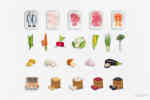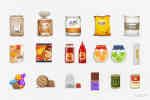Step 4 of 6•6 minutes read
Your Food Groups
HIGH-RISK FOOD: (ready to eat) They are high risk as people WILL eat them!
- Ready to eat food that supports rapid pathogenic bacterial growth (primarily high protein foods).
- High-risk food must be kept under temperature control outsidedanger zone 5-63°C (Rapid bacteria growth).
- High-risk food can act as "vehicles" for outbreaks of food poisoning & illness (people sneezing on high-risk food for example).
The image below shows examples of high-risk foods. People will eat these without any further action to kill bacteria i.e: cooking to a high temperature. High-risk foods are the ones you serve directly to your guests, they may help themselves from a buffet or the crew will help themselves from the crew mess.

High Risk Food
Raw Food to Be Cooked
- This food is intended to be cooked.
- Raw food to be cooked can be MAJOR source of food poisoning bacteria.
- Normally found in the galley, not guest and crew areas.
- Raw food to be cooked MUST be kept away from high risk ready to eat food (Cross-contamination).
- Raw food to be cooked perishable and supports the multiplication of bacteria.
- Watch out for cross-contamination during delivery and storage.
- Cooking food above 75°C will kill the bacteria.
The image below shows examples of raw food to be cooked. They are likely to have pathogenic bacteria but they are not high risk as they are not ready to eat foods. Some of the items below can be eaten raw (e.g. carrots and radish) but they MUST be peeled and/or washed thoroughly. They are mostly cooked before eating but be aware that they are classed as raw food to be cooked and stored and prepared away from raw ready to eat foods.

Raw food to be cooked
Raw Food Ready to Eat
- Raw food ready to eat may have low-dose bacteria on them.
- Raw food ready to eat must be washed in potable (drinking) running water or blanched.
- Think about your smoothies and juices are preparing the ingredients.
- Think about the smoothies and juicing equipment and sanitising.
- Raw food ready to eat can be washed in potassium permanganate to kill bacteria (follow instructions on the label).
- Make sure you sanitise your sink and preparation areas after use.
- Watch out for cross-contamination during delivery and storage.
The image below shows examples of raw food ready to eat. These foods are often not washed and stored away from the raw vegetables that are more likely to be cooked before eating. They can also have chemicals on them from farms that can be harmful to humans.
There have been many reported cases of watermelons being cut without washing. The fleshy part of the juicy watermelon has been contaminated by the knife now covered with bacteria and on the hands of the food handler.

Raw Food Ready to Eat
Low Risk
- They do not support the multiplication of pathogenic bacteria (low water, low protein, high salt or sugar).
- Rarely cause food poisoning.
- Low risk foods can generally be stored in the pantry or galley dry stores.
- Once powders like stock, gravy and milk are re-hydrated with water they are then HIGH RISK.
The below image shows examples of low-risk foods. These foods generally have a long shelf life and can be stored safely in bulk for the convenience of the food operation.

Low Risk Foods
Let us watch this video to test our knowledge on what we have learned so far.
Remember high risk foods are food that is ready for guests and crew to eat. They are generally high in protein. If eaten hot, serve straight after cooking or hold above 63°C. If eaten cold, make sure they are 5°c or below. They can be easily contaminated, so keep covered.